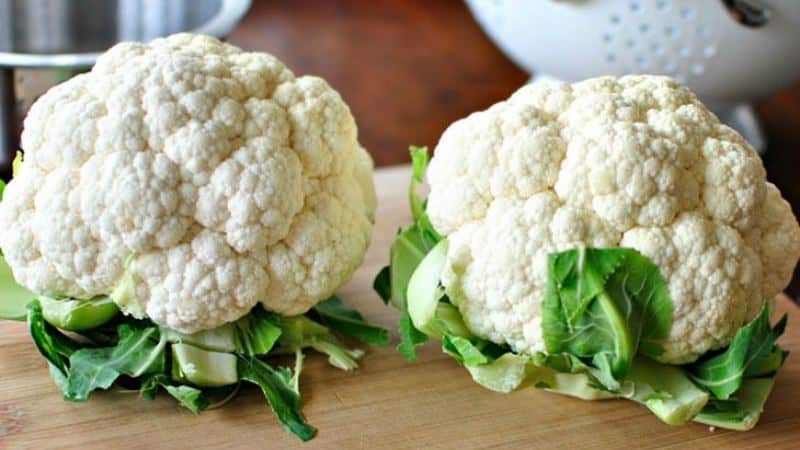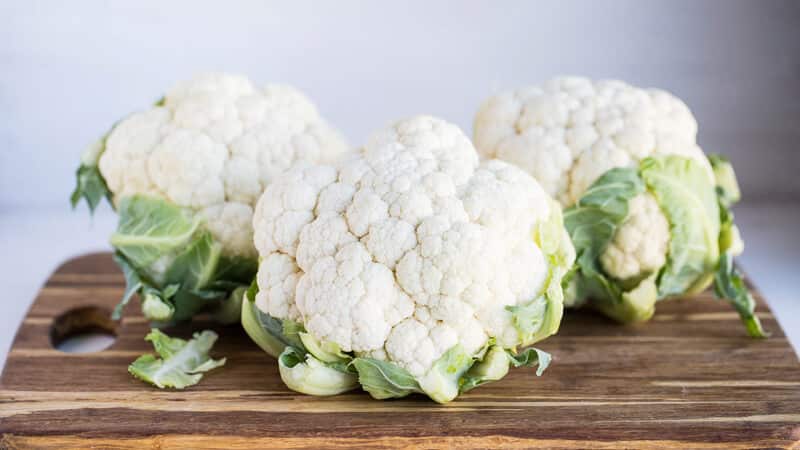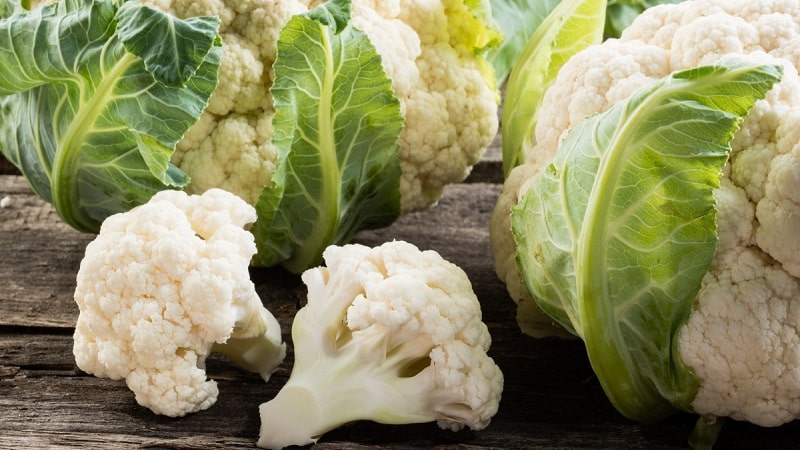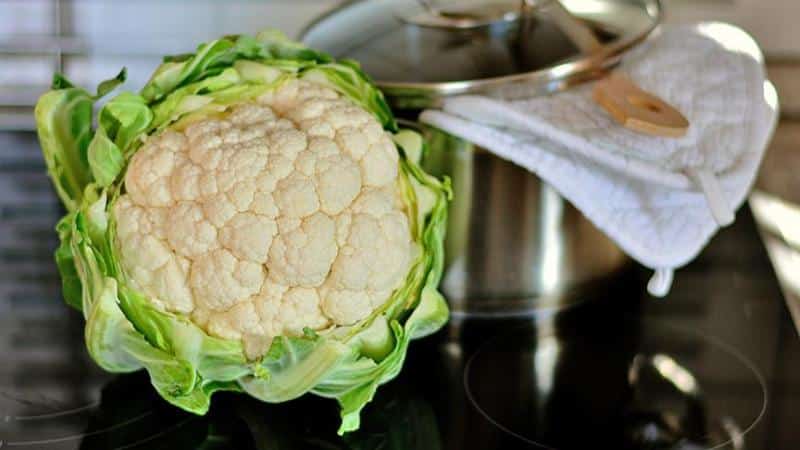Is it possible to include cauliflower in the diet while breastfeeding?
The diet of a nursing mother in the first few weeks after birth is always as strict as possible. Each product introduced into the diet must be approved by a doctor and guaranteed not to cause health problems for the baby. Vegetables are the first to be introduced into the menu, but nursing mothers treat cabbage of any kind, including cauliflower, with caution, fearing that the baby will have a swollen belly. However, this has nothing to do with cauliflower - the vegetable is one of the safest and extremely rarely leads to any negative consequences.
Can I eat cauliflower while breastfeeding?

Cauliflower allowed to all breastfeeding women - it is included in the category of products that can be eaten, even if the child was born with a tendency to allergies.
Doctors do not advise rushing to introduce vegetables into the menu in the first 2-3 weeks after birth: until the baby’s digestive system is stronger, you should refrain from any cabbage.
Three weeks after giving birth, the mother can make herself a soup from pureed inflorescences or stew them with other vegetables. After three months, cabbage in any form, except fried, is allowed to be consumed.
Contraindications
Cauliflower is the safest product possible; it is often chosen for first complementary feeding. When breastfeeding, you can eat vegetables without fear if there is no individual intolerance to the product (for example, constant bloating and discomfort after eating) and a pronounced food allergy in the mother or baby.
Reference. Allergies to cauliflower are rare - and even those cases that have been identified have shown a reaction not to the vegetable itself, but to the chemicals that accumulate in it. Therefore, the most important thing is to choose the right product so that it is environmentally friendly and of high quality.
Benefits and harms
A mother or baby may have problems when consuming a vegetable only if it has been spoiled or grown with the use of pesticides and nitrates. In all other cases, cabbage will only bring benefits.
For mother

Boiled, steamed or baked inflorescences have the highest nutritional value. They will perfectly compensate for the lack of vitamins and microelements in the body, depleted by pregnancy and breastfeeding.
The vegetable contains B vitamins, vitamin C, E, K, as well as potassium, magnesium, phosphorus, iron and calcium. The range of useful properties is extensive:
- Fresh cabbage contains flavonoids - substances that increase the body's defenses and are necessary for the full functioning of the cardiovascular system. For women who suffered from high or low blood pressure during pregnancy, the vegetable will be especially useful.
- Cabbage is hypoallergenic - the risk of a negative reaction in an infant is almost zero.
- Stewed and boiled cabbage recommended if the mother follows a gentle diet, since the product is easily digestible and does not irritate the gastric mucosa. After childbirth, many suffer from constipation - the vegetable is able to completely cope with this problem in a few days.
- If a young mother wants to lose extra pounds gained during pregnancy, boiled inflorescences will be an ideal helper, since they contain only 23 kcal per 100 g with high nutritional value.
Cauliflower contains little coarse fiber - only about 2 g per 100 g of fresh vegetable. Fiber is what causes bloating and stomach pain. in nursing mothers. Therefore, all other types of cabbage are not recommended in the diet until the baby is 6 months old. Cauliflower is completely safe in this regard.
For a child
Even if a product causes bloating and increased gas production in the mother, it is not at all a fact that the baby will have the same reaction.
Colic is a normal reaction of a newborn’s body to the colonization of the digestive system with bacteria that it later needs to digest food. Most modern doctors do not associate colic with the mother’s diet.
Cabbage may have a slight effect on your baby's stool - making it looser. Otherwise, most children do not have any negative manifestations.
Rules for use during lactation

Tender cauliflower can also be eaten fresh, adding a little to salads and soups. But it is tastier and safer for a nursing mother to consume it:
- boiled;
- baked with a little butter;
- steamed;
- stewed with other vegetables or meat.
During seasonal colds, doctors recommend that young mothers eat about 400 g of cauliflower per week to maintain immunity.
How and when to introduce it into the diet
In the first two weeks after giving birth, you should avoid any types of cabbage.
Once the newborn reaches three weeks, you can prepare a little (about 100 g) of boiled or baked vegetables, without adding any other new foods to the diet.
When the child turns two months old, the amount of product is increased to 250 g per day.If the baby and mother feel well, the vegetable may well become one of the foundations of the diet.
What time of day and how much is there?

When breastfeeding any new product is introduced in the morning or afternoon. The first dose is no more than 100 g, if there are no negative reactions, increase daily consumption to 250 g per day.
After a month, you can eat puree soup or stewed vegetables in the evening, but there should be at least three hours left before bed.
What to combine with
Pairs cauliflower with:
- any other vegetables;
- meat: chicken breast, lean beef;
- cheese;
- cereals;
- with cream and butter.
It is not advisable to combine different types of cabbage with each other - for example, white cabbage and broccoli with cauliflower.
Is it possible to give it to a child?

Cauliflower is recommended as a first complementary food, as it does not cause allergies, intestinal irritation and is rich in vitamins.
- Cabbage contains a lot of iron - it is traditionally included in the diet of children with low hemoglobin.
- Plant protein gives you a feeling of fullness.
- Thanks to the presence of light fiber, metabolism improves.
- Bones are strengthened and the elasticity of blood vessels increases.
If the baby is breastfed, vegetables are introduced into the diet from 6 months, if on artificial feeding - from 5 or even 4, on the recommendation of the pediatrician.
How to choose the right one

It is best to buy cabbage from a familiar farmer or in trusted stores that sell organic products.
Basic rules when choosing:
- the head of cabbage should be white, without black spots and rotten parts;
- the leaves on the stalk are rich green;
- the head of cabbage should not be loose;
- the inflorescences are pressed against each other and without defects.
If you have doubts about the quality of a vegetable, it is better not to buy it or, as a last resort, cook it in two waters, be sure to drain the first one.
Recipes with cauliflower for nursing mothers
Boiled cauliflower is a great snack or salad ingredient for a new mother. The vegetable is also consumed as a side dish, seasoned with butter, or as part of vegetable soup. For puree soup, you can take frozen cauliflower - it retains almost all the vitamins, and in winter it is more accessible and cheaper than fresh.
As a main dish, it is easy to prepare vegetable stew with chicken. For it you will need:
- inflorescences of one cauliflower;
- 2 large sweet carrots;
- 2-3 potatoes;
- chicken breast weighing 150-200 g;
- greenery.
Peeled and diced potatoes and carrots are mixed with chopped meat, poured with cold water, and simmered for 25 minutes. Then cabbage inflorescences are added to the boiling stew and salted. Simmer the dish under the lid for about 10 minutes, after turning off the heat, add chopped herbs.
The stew is served with cream or cold-pressed vegetable oil.
For breakfast you can cook omelette with cauliflower and herbs. Small cabbage inflorescences are mixed with beaten egg, butter and herbs, placed in a heat-resistant form and baked in the oven for 15-20 minutes.
Important! During breastfeeding, it is better to avoid fried dishes with cauliflower. They can cause intestinal upset and liver problems in the infant.
Conclusion
During breastfeeding, cauliflower is not only possible, but also recommended to be included in the diet - it is rich in microelements, vitamins, vegetable protein and practically does not contain coarse fiber.However, it is important to prepare it correctly - stew, boil or bake, and choose high-quality vegetables grown without the use of growth stimulants and other chemicals.